(6.) Enhueber’s “Dissertation against Walchius’ view of Adoptionism.” Sidenote: Ibid., 338-438.
(7.) Dunham. “History of Spain and Portugal” (Lardner), 1832. Buckle, “Civilization in England,” p. 430, says of this history, very extravagantly, that it is “perhaps the best history in the English language of a foreign modern country.” It certainly has the merit—no small one in so confused a period—of being clear and succinct; but he has a bias against the Moors.
(8.) W.H. Prescott. “Ferdinand and Isabella.” An excellent work. The parts chiefly bearing on the present subject are the Introduction and chapter viii. The great drawback to the work is the want of direct citations of authorities used.
(9.) Hardwicke’s “History of the Christian Church in the Middle Ages,” 1853.
(10.) The Abbe Rohrbacher. “Histoire Universelle de l’Eglise Catholique.” Paris, 1844. Vols. xi., xii., xiii.
(11.) Neander. “General History of the Christian Religion and Church” (Bohn’s Translation). Vol. v. pp. 218-233, 461-475; vol. vi. 119-132.
(12.) “Histoire d’Afrique et de l’Espagne sous la domination des Arabes,” par M. Cardonne. 3 vols., 1765. A history based chiefly on Arab writers, but not very trustworthy, as Conde (Pref., p. 14) and Murphy (notes, passim) have shown.
(13.) Dozy. “Histoire des Mussulmans d’Espagne jusqu’ a la conquete de l’Andalousie par les Almoravides, 711-1110.” 4 vols., Leyden, 1861. An invaluable history of the time, being both lucid and thorough.
(14.) E.A. Freeman. “History and Conquests of the Saracens.” Six lectures (ed. 1870). Spanish affairs are treated rather as a [Greek: parergon] in Lecture v. An unprejudiced and accurate writer, with a strong bias, however, against chivalry (see Lecture v., p. 182).
(15.) Ockley. “History of the Saracen Empire” (Reprint in the Chandos Classics).
(16.) Gibbon. The parts relating to the Saracens are conveniently reprinted in the “Chandos Classics.”
(17.) Robertson’s “History of the Christian Church.” Vol. iii.
(18.) Milman’s “Latin Christianity.” Bk. ix.
(19.) Stanley. “Lectures on the Eastern Church.” Lect. viii.
(20.) Hallam’s “Middle Ages.” Vol. iii. (Chivalry).
(21.) Geddes. Expulsion of the Moriscoes, in his Miscellaneous Tracts. 1730. Also Account of MSS. and Relics found at Granada in 1588; and View of Court of Inquisition in Portugal.
(22.) Lecky’s “Rise and Influence of Rationalism in Europe.” 2 vols.
(23.) Buckle. “History of Civilisation in England,” chap. viii. “Spanish Intellect from Fifth to Nineteenth Centuries.” Vol. ii. pp. 425-597.
(24.) Carlyle. “Hero Worship. The Hero as Prophet.”
(25.) C.M. Yonge. “Christians and Moors in Spain.” “Golden Treasury” Series. 1878. Obscure in method, and often inaccurate in facts. To give one instance only out of many—The authoress says (p. 29), that Ali, the son-in-law of the Prophet rebelled and died in battle. It is well known (Gibbon, vi. 274, 276) that he did neither.




